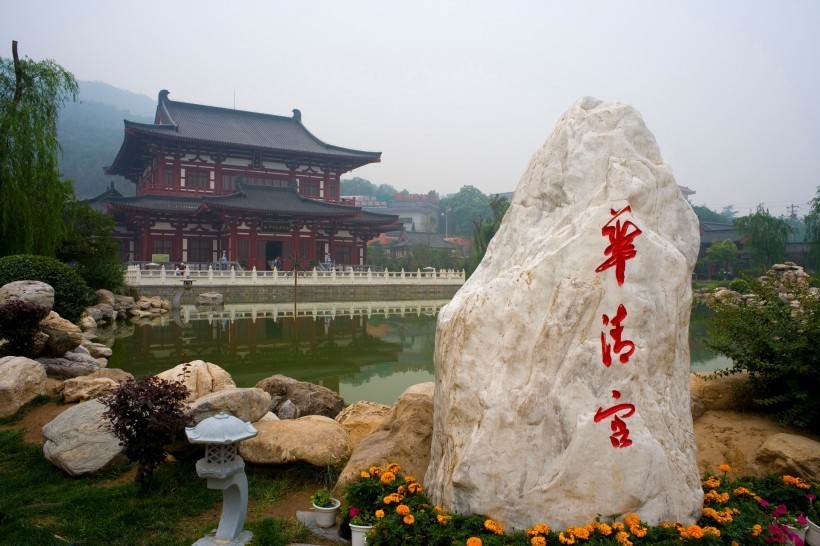- Visitor
Sign In - Official
Wechat![]() Official Wechat
Official Wechat - Visitor
Record - Contact
us - Top
Bell Tower
The Bell Tower, is a stately traditional building, that marks the geographical center of the ancient capital. From this important landmark extend East, South, West and North Streets, connecting the Tower to the East, South, West and North Gates of the City Wall of the Ming Dynasty.
The wooden tower, which is the largest and best-preserved of its kind in China, is 36 meters (118 feet) high. It stands on a brick base 35.5 meters (116.4 feet) long and 8.6 meters (28.2 feet) high on each side. During the Ming Dynasty, Xian was an important military town in Northwest China, a fact that is reflected in the size and historic significance of its tower.
The tower was built in 1384 by Emperor Zhu Yuanzhang as a way to dominate the surrounding countryside and provide early warning of attack by rival rulers.
The tower has three layers of eaves but only two stories. Inside, a staircase spirals up. The grey bricks of the square base, the dark green glazed tiles on the eaves, gold-plating on the roof and gilded color painting make the tower a colorful and dramatic masterpiece of Ming-style architecture. In addition to enhancing the beauty of the building, the three layers of eaves reduce the impact of rain on the building.
On the second floor, a plaque set in the west wall records the relocation of the tower in 1582. When it was first built in 1384, it stood near the Drum Tower on the central axis of the city, and continued to mark the center of the city since Tang Dynasty and the following the Five Dynasties and the Song and Yuan Dynasties. As the city grew, however, the geographical center changed. Therefore, in 1582, the Tower was moved 1,000 meters (3,280 feet) east of the original site. Except for the base, all parts are original, and history tells us that the relocation was accomplished quickly and inexpensively, making it a truly notable achievement in the architectural history in China.
Originally, the northwest corner of the tower housed the famous Jingyun Bell from the Tang Dynasty. Legend has it that although nothing had changed in the tower, the Jingyun Bell fell silent during the Ming Dynasty, so the current bell, a much smaller one weighing only 5 tons, was cast. The original Jingyun Bell can now be seen in Forest of Stone Steles Museum.
The engravings on the doors of the Tower reflect the decorative fashion of Ming and Qing Dynasties, recounting popular stories of ancient China.
On each side of the base, there is an arched door 6 meters (19.6feet) high. In the past, vehicles were allowed to pass through the arches and under the tower, but as the city has grown the volume of traffic has become too great, so a bright, spacious pedestrian subway has been constructed under the tower. The entrance to the tower is from this subway.
A fenced-in area around the tower is planted with grass and flowers. In early spring, the tender plum blossoms and bright new grass surrounding the old tower provide a harmonious contrast. Not far from the Tower, modern shopping malls and a brightly decorated square reveal the prosperity of the city. When night falls, lanterns hung from the eaves illuminate the tower, making it even more enchanting.
The Bell Tower definitely deserves a visit on your trip to Xian.
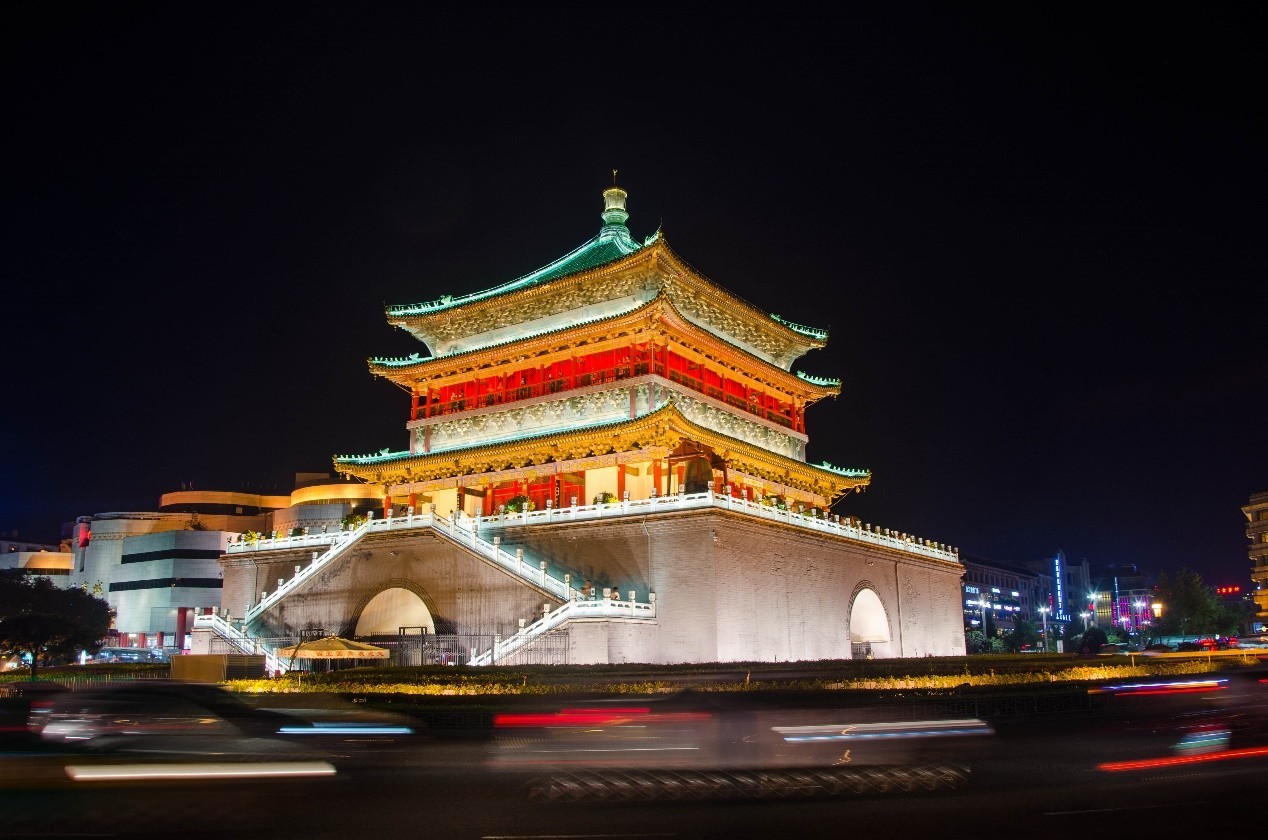
Drum Tower
The Drum Tower is located northwest of the Bell Tower of Xi'an, across the Bell and Drum Tower Square. Both of them are called the 'sister buildings' or 'morning bell and dark drum'. In ancient China, especially from the Yuan Dynasty (1271-1368), the drums were used to signal the running of time and on occasion were used as an alarm in emergency situations.
It was initially built in 1380 during the reign of Emperor Hongwu of the Ming Dynasty (1368-1644), and was renovated twice in 1699 and 1740 in the Qing Dynasty (1644-1911). It is a two-storied post and panel structure, 34 meters (about 112 feet) high and 52.6 meters (about 172 feet) long from east to west as well as 38 meters (about 124 feet) wide from north to south. The architecture style of the Drum Tower is a combination of the styles of the Tang Dynasty (618-907) and the Qing Dynasty. However, it also has some innovative features. For example, it should be mentioned that there is no iron nail used anywhere in the Tower.
Upon arrival you will see that there is an arched doorway in the centre of the south and north walls, doorway being 6 meters (about 20 feet) in both height and width. The north entrance leads to Beiyuan Men and south to the West Avenue. Visitors can go upstairs to the second floor, and enjoy the views around the Drum Tower. On the second floor, there is a drum culture exhibition which can help you know more about drums. Meanwhile, you will notice that there are twenty-four drums in its north and south sides. They stand for the Twenty-four Solar Terms which is a kind of weather calendar created by the Chinese ancients in order to guide the agricultural production.
In modern times, the Drum Tower is not used as a timer any more, but there are some new attractions for visitors to enjoy. In the year of 1996, a new drum, covered by a whole piece of cowhide was given a place on the Tower. It is the biggest drum in China at present. What is more, visitors will enjoy musical performances inside it. These performances will enlighten one on the power of ancient Chinese culture.
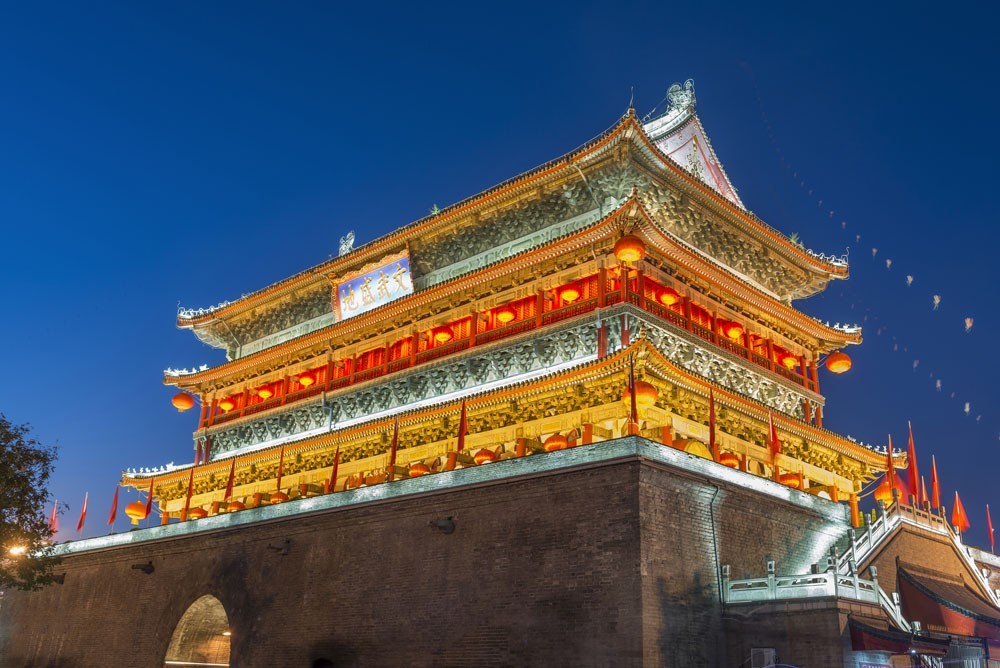
Big Wild Goose Pagoda (Dayan Ta)
As the symbol of the old-line Xian, Big Wild Goose Pagoda is a well-preserved ancient building and a holy place for Buddhists. It is located in the southern suburb of Xian City, about 4 kilometers (2.49 miles) from the downtown of the city. Standing in the Da Ci'en Temple complex, it attracts numerous visitors for its fame in the Buddhist religion, its simple but appealing style of construction, and its new square in front of the temple. It is rated as a National Key Cultural Relic Preserve as well as an AAAA Tourist Attraction.
This attraction can be divided into three parts: the Big Wild Goose Pagoda, the Da Ci'en Temple, and the North Square of Big Wild Goose Pagoda.
Big Wild Goose Pagoda
Originally built in 652 during the reign of Emperor Gaozong of the Tang Dynasty (618-907), it functioned to collect Buddhist materials that were taken from India by the hierarch Xuanzang.
Xuanzang started off from Chang'an (the ancient Xian), along the Silk Road and through deserts, finally arriving in India, the cradle of Buddhism. Enduring 17 years and traversing 100 countries, he obtained Buddha figures, 657 kinds of sutras, and several Buddha relics. Having gotten the permission of Emperor Gaozong (628-683), Xuanzang, as the first abbot of Da Ci'en Temple, supervised the building of a pagoda inside it. With the support of royalty, he asked 50 hierarchs into the temple to translate Sanskrit in sutras into Chinese, totaling 1,335 volumes, which heralded a new era in the history of translation. Based on the journey to India, he also wrote a book entitled 'Pilgrimage to the West' in the Tang Dynasty, to which scholars attached great importance.
First built to a height of 60 meters (197 feet) with five stories, it is now 64.5 meters (211.6 feet) high with an additional two stories. It was said that after that addition came the saying-'Saving a life exceeds building a seven-storied pagoda'. Externally it looks like a square cone, simple but grand and it is a masterpiece of Buddhist construction. Built of brick, its structure is very firm. Inside the pagoda, stairs twist up so that visitors can climb and overlook the panorama of Xian City from the arch-shaped doors on four sides of each storey. On the walls are engraved fine statues of Buddha by the renowned artist Yan Liben of the Tang Dynasty. Steles by noted calligraphers also grace the pagoda.
As for the reason why it is called Big Wild Goose Pagoda, there is a legend. According to ancient stories of Buddhists, there were two branches, for one of which eating meat was not a taboo. One day, they couldn't find meat to buy. Upon seeing a group of big wild geese flying by, a monk said to himself: 'Today we have no meat. I hope the merciful Bodhisattva will give us some.' At that very moment, the leading wild goose broke its wings and fell to the ground. All the monks were startled and believed that Bodhisattva showed his spirit to order them to be more pious. They established a pagoda where the wild goose fell and stopped eating meat. Hence it got the name 'Big Wild Goose Pagoda'.
Da Ci'en Temple
Da Ci'en Temple is the home of Big Wild Goose Pagoda. In 648, to commemorate the dead virtuous queen, royalty ordered the building of a temple named 'Ci'en' (Mercy and Kindness), for which the status and scale far exceeded all others. Today, with an area of 32,314 square meters (38,648.5 square yards), one seventh of the original area, it still retains its grandeur.
Before the temple, there stands a statue of hierarch Xuanzang, the meritorious hierarch. Walking on and across a small bridge, visitors will see the gates of the temple. With guarding lions, the temple seems stately for lions were said to function as talismans.
Entering the temple you will see two buildings-Bell Tower in the east and Drum Tower in the west. Inside the Bell Tower hangs an iron bell 15 tons (14.76 gross tons) in weight. It was molded in 1548 in the Ming Dynasty (1368-1644). Along the central axis are arranged the Hall of Mahavira, Sermon Hall, Big Wild Goose Pagoda, and the Hall of Xuanzang Sanzang. In the Hall of Mahavira are three carved statues of Sakyamuni, and 18 arhats as well as Xuanzang. The Sermon Hall is where Buddhist disciples would listen to a sermon. A bronze statue of Amitabha is dedicated and a Buddha statue is collected by Xuanzang as oblation. The Hall of Xuanzang Sanzang is north of Big Wild Goose Pagoda. In this hall are Xuanzang's relic and a bronze statue of a seated Xuanzang. The inner wall is chiseled with murals depicting this hierarch's story. Renowned as the contemporary Dunhuang Buddhist storehouse praised by UNESCO, it is the biggest memorial of Xuanzang.
North Square of Big Wild Goose Pagoda
Surrounding Big Wild Goose Pagoda, the scenery is also quite charming, especially the square north of the Da Ci'en Temple. Covering about 110,000 square meters (131563 square yards) plus 20,000 square meters (23920.6 square yards) of water area, it holds many records: in Asia, it is the biggest Tang-culture square, the biggest fountain and waterscape square, and the largest-scale sculptures area. In the world, it has the most benches, the longest light-belt, and the largest-scale acoustic complex.
The entire square is composed of waterscape fountains, a cultural square, gardens and tourist paths. There you can taste real Chinese culture and traditions and fully enjoy the truly attractive views. With reliefs on the theme of the prosperous Tang Dynasty, 200-meter-long (656-foot-long) sculpture groups, 8 groups of sculpted figures, 40 relievos on the land, and 22 styles of musical fountains, it has become a must-see when you visit Big Wild Goose Pagoda.
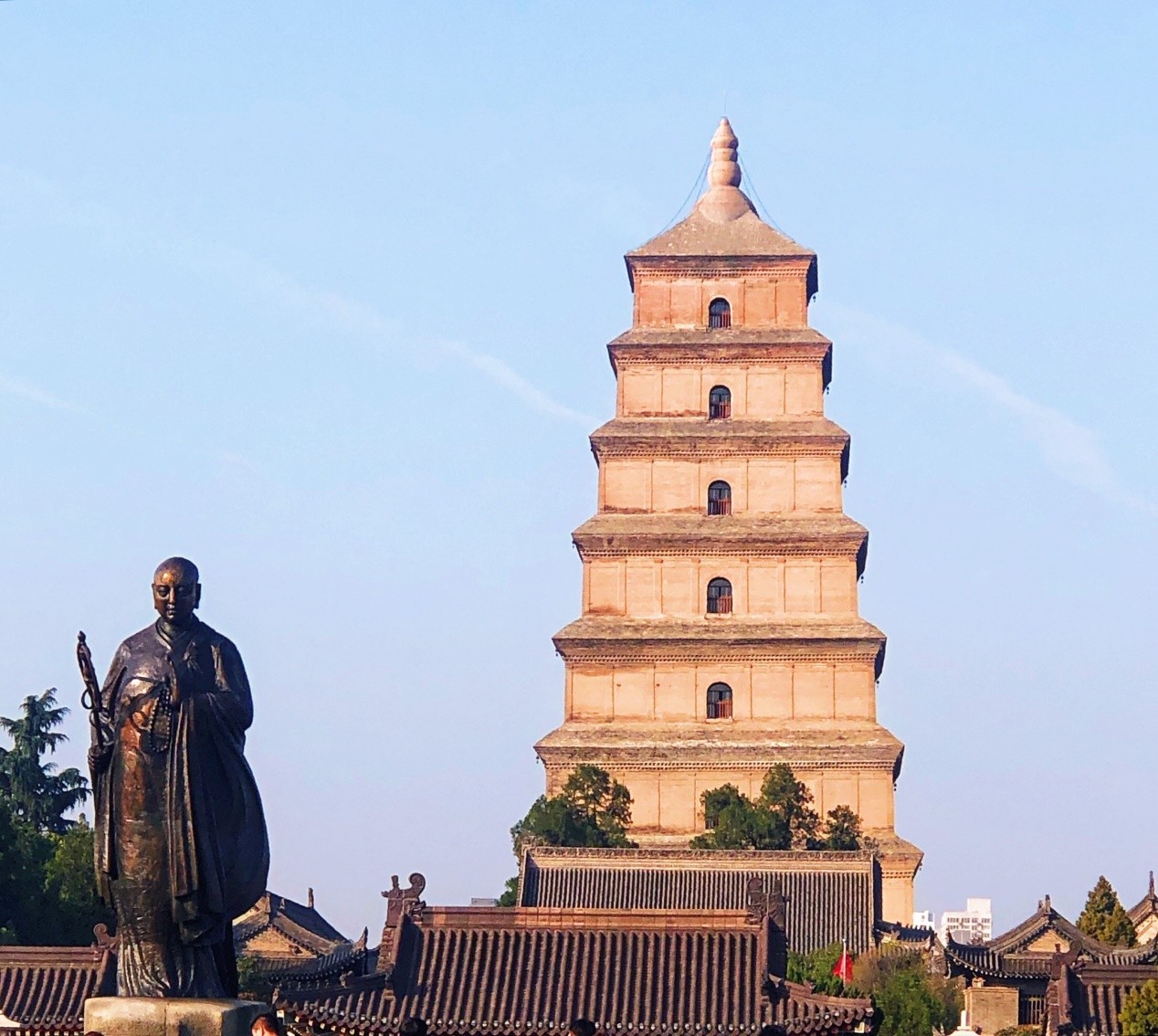
Xian City Wall
When Zhu Yuanzhang, the first Emperor of the Ming dynasty (1368-1644), captured Huizhou, a hermit named Zhu Sheng admonished him that he should 'built high walls, store abundant food supplies and take time to be an Emperor,' so that he could fortify the city and unify the other states. After the establishment of the Ming dynasty, Zhu Yuanzhang followed his advice and began to enlarge the wall built initially during the old Tang dynasty (618 -907), creating the modern Xian City Wall. It's the most complete city wall that has survived in China, as well being one of the largest ancient military defensive systems in the world.
After the extension, the wall now stands 12 meters (40 feet) tall, 12-14 meters (40-46 feet) wide at the top and 15-18 meters (50-60 feet) thick at the bottom. It covers 13.7 kilometers (8.5 miles) in length with a deep moat surrounding it. Every 120 meters, there is a rampart which extends out from the main wall. All together, there are 98 ramparts on the wall, which were built to defend against the enemy climbing up the wall. Each rampart has a sentry building, in which the soldiers could protect the entire wall without exposing themselves to the enemy. Besides, the distance between every two ramparts is just within the range of an arrow shot from either side, so that they could shoot the enemy, who wanted to attack the city, from the side. On the outer side of the city wall, there are 5948 crenellations, namely battlements. The soldiers can outlook and shoot at the enemy. On the inner side, parapets were built to protect the soldiers from falling off.
Since the ancient weapons did not have the power to break through a wall and the only way for an enemy to enter the city was by attacking the gate of the city wall. This is why complicated gate structures were built within the wall. In Xian, the city wall includes four gates and they are respectively named as Changle (meaning eternal joy) in the east, Anding (harmony peace) in the west, Yongning (eternal peace) in the south and Anyuan (forever harmony) in the north. The south gate, Yongning, is the most beautifully decorated one. It is very near to the Bell Tower, center of the city. Important greeting ceremonies organized by the Provincial Government are usually held in the south gate square.
Each city gate has three gate towers: Zhenglou, Jianlou and Zhalou. The most outside is Zhalou, which stands away from the City Wall and is opposite to Zhenglou. It was used to raise and lower the suspension bridge. Jianlou with small windows in the front and flanks was used as a defensive outpost. Zhenglou, in the inner, is the main entrance to the city. The wall connects Jianlou and Zhenglou Towers. The area between them within the wall was called 'Wong Cheng', in which the soldiers stationed. From Wong Cheng, there are sloped horse passages leading to the top of the city wall.
Initially, the wall was built with layers of dirt, with the base layer including also lime and glutinous rice extract. Throughout the time Xian City Wall has been restored three times. In 1568, Zhang Zhi (the government officer of that period) was in charge to rebuild the wall with bricks. In 1781, another officer, Bi Yuan, refitted the city wall and the gate towers. More recently (since 1983) the Shaanxi Provincial Government restored the city wall again. A circular park has been built along the high wall and the deep moat. The thriving trees and flowers decorate the classical Chinese architecture of the wall, adding additional beauty to the city of Xian.
A nice suggestion for tourists: Try biking on the City Wall, you will have an enjoyable and interesting experience.
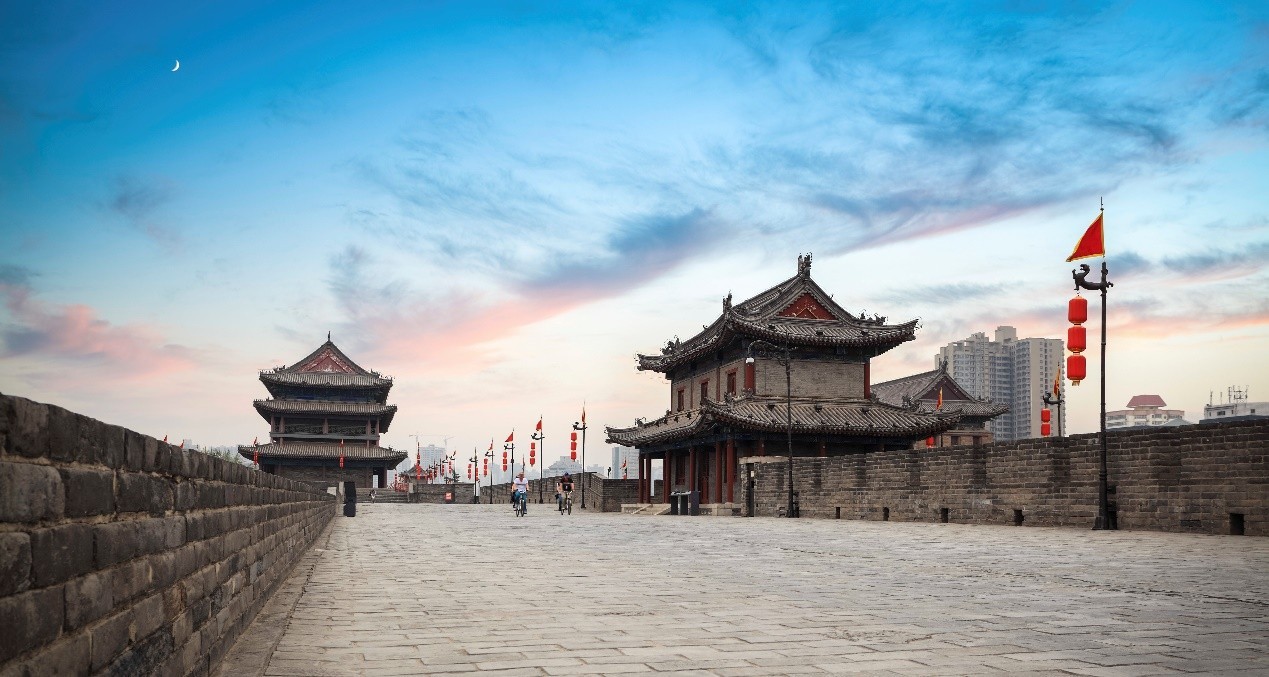
Shaanxi History Museum
Completed on June, 1991 and officially opened to the public ever since, Shaanxi History Museum covers a land area of 65000 m2 with the exhibition area amounting to 11000 m2. Constructed in the style of Tang architecture “the central halls surrounded by high towers”, the large and elegant buildings have integrated the ancient architecture with modern technology. The Museum houses a collection of more than three hundred and seventy thousand pieces of precious cultural relics, large in quantity, complete in variety and high in grade. Among the treasures the mural paintings collected from about 20 tombs of Tang Dynasty account for approximately 1000 square meters, ranking No.1 among the Chinese museums.
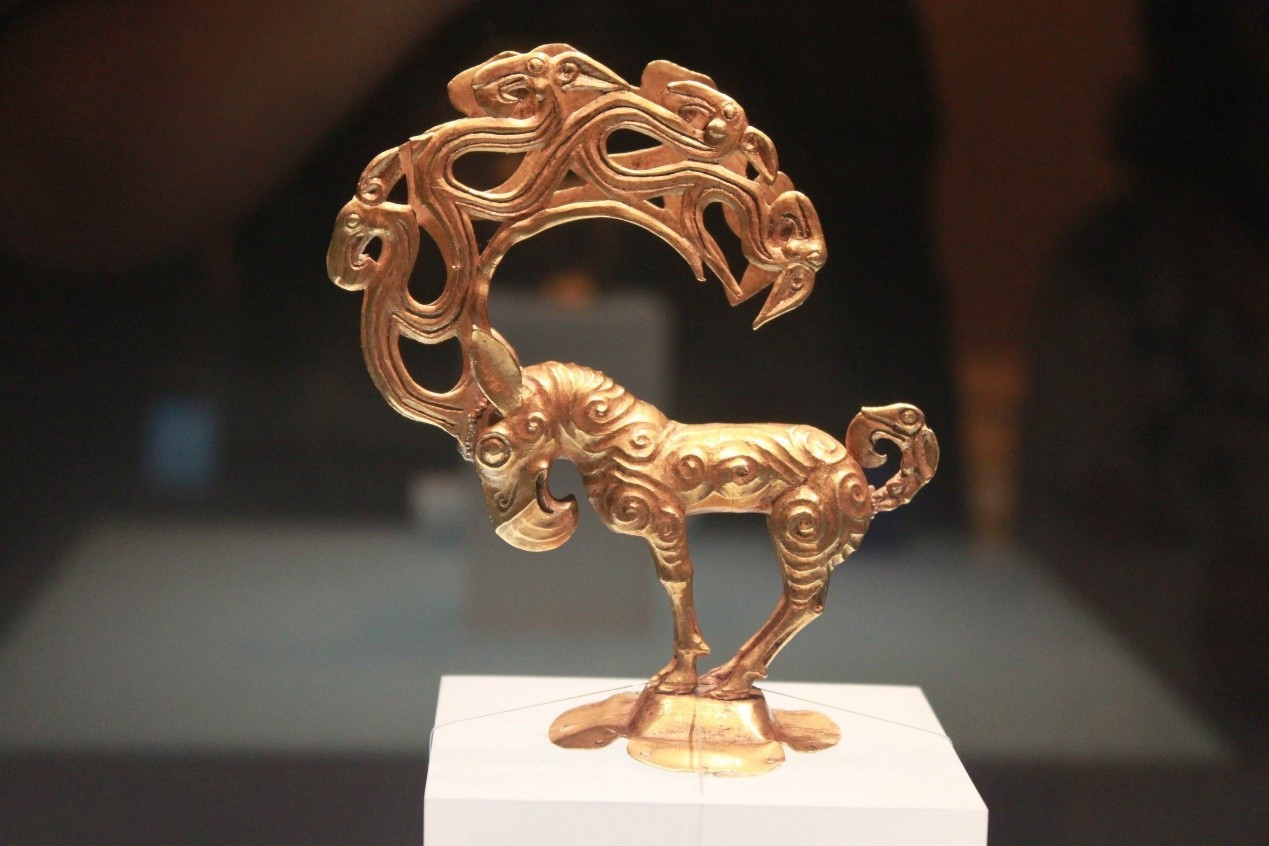
Tang Paradise
Near the Big Wild Goose Pagoda , Tang Paradise is located in the Qujiang Resort, southeast of the Xian City, Shaanxi Province. It is a newly opened tourist attraction in April, 2005. Tang Paradise covers a total area of 1000 mu (about 165 acres) and of which 300 mu (about 49 acres) is water. This tourist attraction not only claims to be the biggest cultural theme park in the northwest region of China but also the first royal-garden-like park to give a full display of the Tang Dynasty's (618-907) culture. Altogether, twelve scenic regions are distributed throughout Tang Paradise to provide visitors with the enjoyment of twelve cultural themes and a perfect exhibition of the grandness, prosperity and brilliance of the culture of the Tang Dynasty.
What makes Tang Paradise incredible is that it is no longer the garden mode of only water and mountains in the Chinese traditional sense. The outstanding designers of the magnificent Tang Paradise have integrated almost everything representative of the Tang Dynasty, such as the poetry, the songs and dance, the marketplaces, the food, the women's lifestyles, and science into every site using cultural themes, thus endowing every place with its own story and its own place in the tapestry of Tang Dynasty culture.
In the large number of buildings at Tang Paradise, one may see almost all architectural types of characteristic of the Tang Dynasty. In addition there are establishments for relaxing and song and dance shows about the civilization of the Tang Dynasty. Strolling in Tang Paradise, you are assured to get a full enjoyment, making you feel as if you were in a fairyland.
Many firsts are created here: the first and largest scale of buildings modeled on the Tang style in China, the first and most considerable groups of sculptures to show the poetic culture in the Tang Dynasty in China, the first and biggest single architecture modeled on the Tang style throughout China, the first theme park in China to cater to the five sense (vision, hearing, smell, touch and taste), the grandest fragrant project of the outdoors in the world, and the most spectacular water film on earth. Tang Paradise is praised as 'Garden of History', 'Garden of Spirit', 'Garden of Nature', 'Garden of Human Culture' and 'Garden of Art'.
The most special and amazing feast in Tang Paradise is taste. The word 'taste' here does not refer to the delicious smell of food, but means that the whole Tang Paradise, like a fair lady, is full of aroma. Unbelievable, isn't it? But definitely true! You may wonder why. The secret is that there are incense burners here. Every few meters on both sides of the paths in Tang Paradise, there is an incense burner which looks like a street lamp. It is only 1.5 meters (about 5 feet) tall with incense coils burning inside. It is this fragrance that makes the whole place seem like mysterious Xanadu. Thus wherever you walk in Tang Paradise, assuredly, you can be embraced by its faint redolence.
In Tang Paradise, another surprising man-made wonder is the water film which claims to be the foremost in the whole world. The screen of the movie is a film of water; thus it can create a special kind of optical effect which makes the frame tridimensional. When watching the movie, you can witness that the beautiful night and the fan-like water surface become an ingenious integration. Every time the figures in the movie appear on the screen, it seems that they are flying to the sky or coming down from the heaven which throws you into a wonderful and illusory feeling that you were personally on the scene. Splendid, indeed!
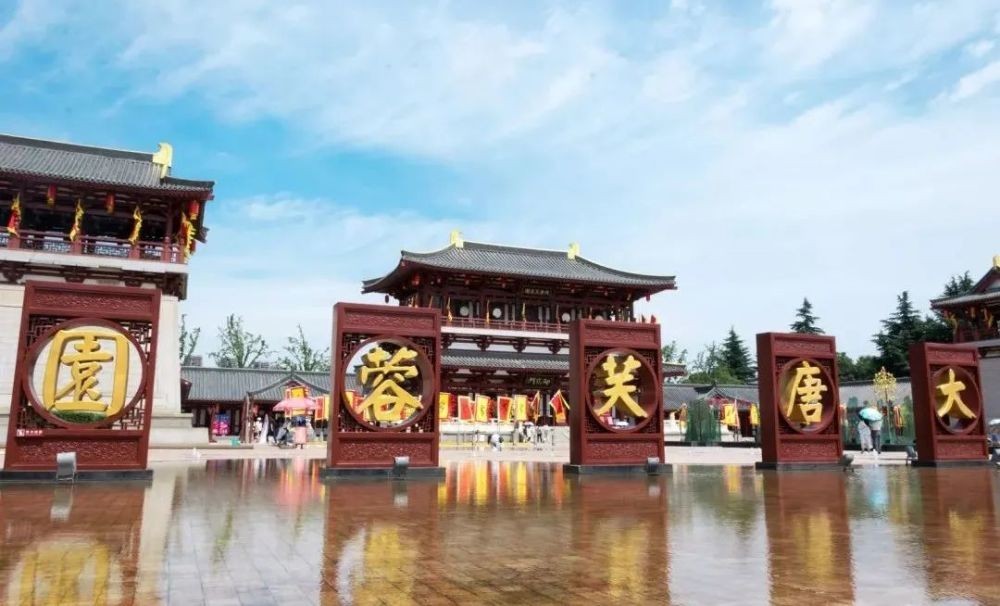
Beiyuanmen
Neighboring to the Bell&Drum Tower Square, this place is located in the busy downtown area of the city. At night this place is beautifully lit and crowded with visitors, boasting of great prosperity. The most well-known snacks here include Pingwa Barbecue, Jiasan soup stuffed buns, and lamb breast in hot chili.
Famous snacks: Fengjiacasserole and barbecue, Special Barbecue, LinyuelouAnjia stir fries, Pingwa barbecue, Laiyite special snacks, Laowujia desserts, Junwa barbecue and spicy hot pot, Lijia fried dumplings, Yifenli noodle house, Lanjia barbecue, Haijia barbecue, Jisan soup stuffed buns, No.1 Shaanxi pita bread soaked in beef/lamb stirfry, Laojinjialamb breast in hot chili, Laoanjia traditional cakes, and Honghong parched rice.
Business hours: 6pm-early morning
Address: Bell&Tower Square and enter from the Drum Tower entrance
How to get there: Take Bus 706 or 707 to Beiyuanmen Stop
Location: East of the West Street (Bell&Drum Tower)
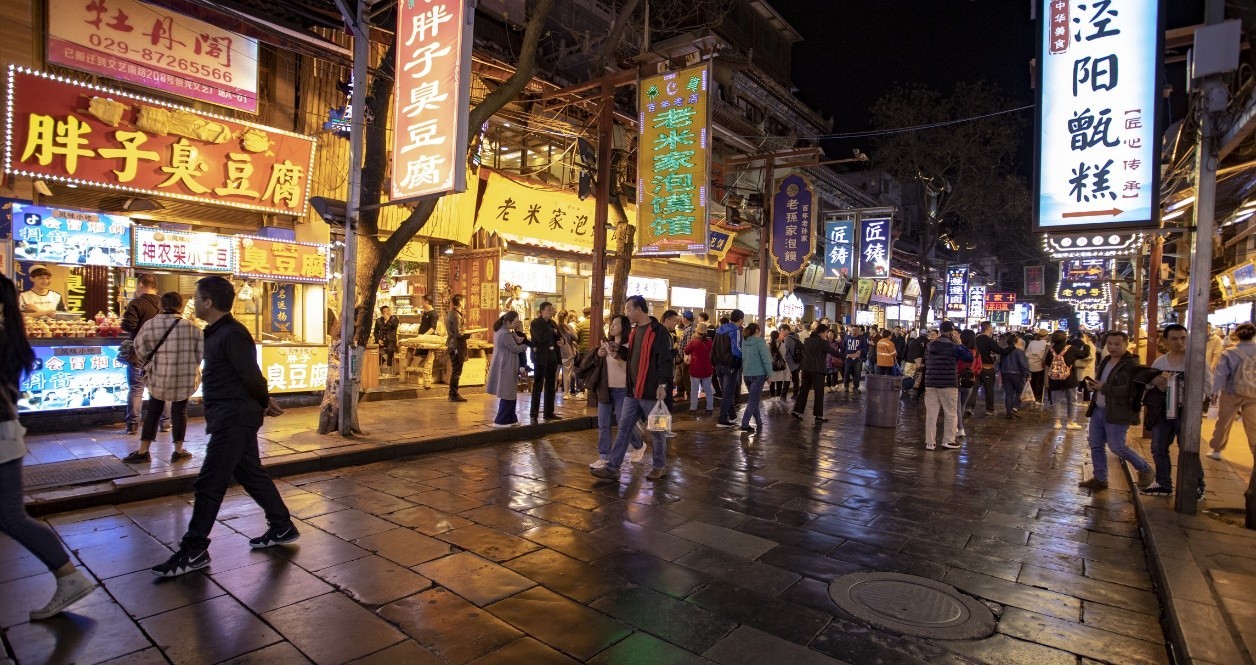
Museum of Qin Terra-cotta Warriors and Horses
The Terra Cotta Warriors and Horses are the most significant archeological excavations of the 20th century. Work is ongoing at this site, which is around 1.5 kilometers east of Emperor Qin Shi Huang's Mausoleum, Lintong County, Shaanxi province. It is a sight not to be missed by any visitor to China.
Upon ascending the throne at the age of 13 (in 246 BC), Qin Shi Huang, later the first Emperor of all China, had work begun on his mausoleum. It took 11 years to finish. It is speculated that many buried treasures and sacrificial objects had accompanied the emperor in his after life. A group of peasants uncovered some pottery while digging for a well nearby the royal tomb in 1974. It caught the attention of archeologists immediately. They came to Xian in droves to study and to extend the digs. They had established beyond doubt that these artifacts were associated with the Qin Dynasty (211 --206 BC).
he State Council authorized to build a museum onsite in 1975. When completed, people from far and near came to visit. Xian and the Museum of Qin Terra Cotta Warriors and Horses have become landmarks on all travelers' itinerary.
Life size terracotta figures of warriors and horses arranged in battle formations are the star features at the museum. They are replicas of what the imperial guard should look like in those days of pomp and vigor.
The museum covers an area of 16,300 square meters, divided into three sections: No. 1 Pit, No. 2 Pit, and No. 3 Pit respectively. They were tagged in the order of their discoveries. No. 1 Pit is the largest, first opened to the public on China's National Day, 1979. There are columns of soldiers at the front, followed by war chariots at the back.
No. 2 Pit, found in 1976, is 20 meters northeast of No. 1 Pit. It contained over a thousand warriors and 90 chariots of wood. It was unveiled to the public in 1994.Archeologists cameupon No. 3 Pit also in 1976, 25 meters northwest of No. 1 Pit. It looked like to be the command center of the armed forces. It went on display in 1989, with 68 warriors, a war chariot and four horses.
Altogether over 7,000 pottery soldiers, horses, chariots, and even weapons have been unearthed from these pits. Most of them have been restored to their former grandeur.
The Terracotta Warriors and Horses is a sensational archeological find of all times. It has put Xian on the map for tourists. It was listed by UNESCO in 1987 as one of the world cultural heritages.

Huaqing Hot Springs
Situated at the northern foot of Mt. Lishan in Lintong County, 30 kilometers (18.6 miles) from Xian City, Huaqing Hot Spring is famed for both its dainty spring scenery and the romantic love story of Emperor Xuanzong (685-762) and his concubine Yang Guifei in the Tang Dynasty (618-907). Its long history and location among the wonderful landscapes of Xian should entice any visitor to visit and bathe in this hot spring.
It is said that King You built a palace here during the Western Zhou Dynasty (11th century BC-711 BC). Additions were subsequently made by the First Emperor Qing (259 BC-210BC) and Emperor Wu during the Western Han Dynasty (206 BC-24). During his reign, the Emperor Xuanzong spent dizzying amounts of his funds to build a luxurious palace, changing its name to Huaqing Hot Spring or Huaqing Palace. Over the course of 41 years in his days, he visited the palace as many as 36 times. The palace thus has a history of 3,000 years and the hotspring a history of 6,000 years! Ranked among the Hundred Famous Garden in China, it is also has the status as a National Cultural Relic Protection Unit and a National Key Scenic Area.
